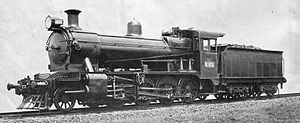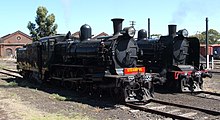Victorian Railways K class
| Victorian Railways K class | |||||||||||||||||||||||||||||||||||||
|---|---|---|---|---|---|---|---|---|---|---|---|---|---|---|---|---|---|---|---|---|---|---|---|---|---|---|---|---|---|---|---|---|---|---|---|---|---|
 VR photo of K 103 as built, 1922 | |||||||||||||||||||||||||||||||||||||
| |||||||||||||||||||||||||||||||||||||
| |||||||||||||||||||||||||||||||||||||
| |||||||||||||||||||||||||||||||||||||
| |||||||||||||||||||||||||||||||||||||
The K class was a branch line steam locomotive that ran on Victorian Railways from 1922 to 1979. Although its design was entirely conventional and its specifications unremarkable, the K class was in practice a remarkably versatile and dependable locomotive. It went on to outlast every other class of steam locomotive in regular service on the VR, and no fewer than 21 examples of the 53 originally built have survived into preservation.
History
The K class was the first design from the VR Locomotive Design Section under the stewardship of Alfred E Smith as Chief Mechanical Engineer.[1]
The Locomotive Design Section had introduced successful mainline and branchline passenger locomotives with the A2 class and Dd class 4-6-0s, and had recently improved mainline goods services with the C class 2-8-0. They now turned their attention to a requirement for a more powerful branchline goods locomotive, and in 1922 produced a lighter 2-8-0 "Consolidation" locomotive with a 13+1⁄2 long tons (13.7 t; 15.1 short tons) axle load and 50 ft (15.24 m) wheelbase, able to run on even the lightest lines on the VR 5 ft 3 in (1,600 mm) system.
Regular service

The K class is credited with working virtually every line in the VR system and hauling almost every kind of train.
A total of ten were built from 1922-23. They were put to work on goods services on steeply graded branch lines where their superior tractive effort (45% higher than that of the Dd class) and high factor of adhesion were put to good use.[2]
The design was modified in 1925 into the N class 2-8-2, in response to a new Victorian Railways policy that all new locomotives be capable of conversion from 5 ft 3 in (1,600 mm) to 4 ft 8+1⁄2 in (1,435 mm) standard gauge in the event of the Victorian Railways network being standardised. (The K, with its firebox mounted between the frames, was unsuitable for standard gauge conversion.)[2]
The K class proved to be such a successful locomotive than during World War II when the VR faced a shortage of motive power on the branchline network, it built a further 43 K class locomotives even though the K was not gauge convertible. The decision to build more Ks reflected their greater versatility: they had the same tractive effort as the N class but unlike the longer wheelbase N class the K could be turned on the smallest (53-foot or 16.15-metre) turntables.
Although originally designed as a goods locomotive, their maximum permissible speed was raised in the 1950s from 45 to 50 mph (72 to 80 km/h) for branchline passenger service, further increasing their versatility.[3]
The success of the K class was such that even in 1953, when dieselisation was already underway on Victorian Railways, the basic design of the K class was updated into the J class 2-8-0, the final class of steam locomotives to be introduced to the Victorian Railways.[2]
Design improvements
During the mid-1930s, the original batch of ten K class locomotives were equipped with VR's 'Modified Front End' for improved drafting and reduced cylinder back pressure. They also saw other improvements, such as the fitting of cross-compound air compressors, smoke deflectors and a new welded tender tank which incorporated a self-trimming coal bunker.
The last seven of the second order of K class locomotives built in 1940-46 were fitted with Boxpok wheels.
Demise
The introduction of the T class (EMD G8) diesel electric locomotive from 1955 onwards on VR's branchline network spelled the beginning of the end for the K class, with Ks gradually being retired as successive orders of Ts were delivered throughout the 1950s and into the 1960s. Even so, their reliable and low-cost operability ensured they remained in service around various yards and depots as shunters and workshop pilots until the Y class (EMD G6B) locomotive eventually superseded them in this role.
On 20 January 1965 locomotive K 188 was used in a public ending of steam on the Victorian Railways, when it was used in the demolition of the North Melbourne Locomotive Depot, pulling down the front wall with a steel rope before a crowd of onlookers.[4] North Ballarat Workshops pilot K 162 had the honour of being the last steam locomotive in service on Victorian Railways, withdrawn in March 1979, and was subsequently allocated to Steamrail Victoria.
Preservation

With the rail preservation movement well under way by the late 1960s, many ex-VR locomotives were sold to local councils for display in municipal parks or near railway stations. The K had a further advantage over other classes in this respect: because VR offered the locomotives for the price of their scrap value (plus the cost of freight to their eventual destination), the relatively lightweight K represented a comparatively cheap locomotive purchase. The large number of preserved K class locomotives is in stark contrast to the fate of VR's remaining fleet of 73 larger, heavier N class locomotives, all of which (other than the one example retained for display at the ARHS Railway Museum) were scrapped.
By the time VR announced the cessation of steam locomotive scrapping in 1978, no fewer than 21 of an original 53 K class locomotives remained in existence, making them in preservation the most numerous class of VR steam locomotives. However, none of the original batch of ten locomotives survives.
Operational

Three K class locomotives are currently in operation:
- K153 and K190 are operated by Steamrail Victoria, hauling special excursion trains to various destinations on the Victorian broad gauge railway network.
- K163 is in regular service on the preserved Mornington Railway, hauling passenger services between Moorooduc and Mornington. K163 was used as the locomotive on train scene in part 3 of The Pacific. As of 7 February 2010, K163 is being overhauled by Mornington Railway Preservation Society. K163 returned into service for the MRPS as of 21 November 2010.
(K160 was in regular service on the Victorian Goldfields Railway until late 2012, at which point it was withdrawn from service pending a major overhaul, ending a 26 year stint in service.)
Static display
K 165 is preserved at the Australian Railway Historical Society Museum at North Williamstown.
In addition, K class locomotives are also preserved on public display at various locations:[5]
- K 162: Yarragon, Victoria (numbered 'K-183': the two locomotives were swapped in 1982 when K 183 commenced restoration to working order, although K 183's tender remains.)[6]
- K 167: Wycheproof, Victoria
- K 169: Coal Creek Heritage Village, Korumburra, Victoria
- K 177: Hamilton, Victoria. This locomotive, swapped with K 159 by the Mornington Railway Preservation Society, is a composite of worn out parts salvaged from K 159, 174 and 177, with the frames, wheels and most of the motion gear being from K 177.[7]
- K 175: Mildura, Victoria
- K 181: Numurkah, Victoria
- K 192: State Coal Mine, Wonthaggi, Victoria
Stored or under restoration
The following K class locomotives are the subject of current restoration projects:
- K 154 was previously on display in the "Old Moe Town" Historical Park. This locomotive is now the focus of the N441 - Steam Locomotive Project to convert the locomotive into a 1st series N class 2-8-2 by the Locomotive Restoration Group based at Newport Workshops.[8]
- The Mornington Railway Preservation Society is well into the restoration of a locomotive to be numbered K 177, which will comprise frames salvaged from K 174, K 177's original boiler, driving wheels from K 176 and a tender made up of K 174's frames and K 177's tender tank.[9]
- K 191, previously on static display in Wangaratta, Victoria, has been stripped down into its component parts for inspection and preliminary work as a restoration project by the Mornington Railway Preservation Society.[10]
Until 2002, K 183 was also operated by Steamrail Victoria. On 13 October 2002 this locomotive was involved in a serious level crossing accident with a B-double semi-trailer near Benalla, Victoria, derailing after impact. Tragically, three people on the footplate died in the collision.[11] The locomotive was extensively damaged and is currently stored out of service.[5] As of 2013, the locomotive is still receiving insurance money from the accident in which will go towards the future restoration of the steam train to its former glory.[12]
In addition, K 151, 157, 159, 176, and 184 are currently stored. While some are potential restoration projects, others such as K 151 and K 157 are utilised as sources of spare parts to restore or maintain other K class locomotives.
Model railways
HO Scale
The VR K Class locomotive was previously available in HO Scale as a brass and Whitemetal kit, by Broad Gauge Models. There were also a limited production run of brass "Ready-to-Run" models produced by Precision Scale Models in the mid-1990s. A limited production run of brass "Ready-to-Run" models was produced by Trainbuilder in 2013/14. A plastic version is currently in development by Eureka Models and is due in 2015.
Trainbuilder has released a series of locomotives, including K150, 160, 164, 175, 186, 188 and 192 in black, and 183 in Steamrail's blue scheme and 190 in Steamrail's green scheme.[13][14]
N Scale
An N scale kit version is available from badgerbits using a MicroAce 9600 as a basis.
References
- Dee; et al. (1981). Power Parade. Melbourne: VicRail Public Relations Division. ISBN 0-7241-3323-2.
{{cite book}}: Invalid|ref=harv(help) - Pearce; et al. (1980). North Williamstown Railway Museum. Melbourne: ARHS. ISBN 0-85849-018-8.
{{cite book}}: Invalid|ref=harv(help) - Oberg, Leon (1975). Locomotives of Australia. Sydney: Reed. ISBN 0-589-07173-4.
{{cite book}}: Invalid|ref=harv(help) - Schrader, Michael (2001). "Recording Railway History - Victoria". Photographer Profile. Studfield: Train Hobby Publication. ISBN 1-876249-54-4.
{{cite book}}: Invalid|ref=harv(help) (includes pictures of K Class locos in action)
- Specific
- ^ "ARHS Railway Museum: History 1900 - 1950". Retrieved 12 November 2006.
- ^ a b c d "Victorian Goldfields Railway Steam Locomotives". Retrieved 11 November 2006.
- ^ Pearce et al., p. 14
- ^ "VR timeline". http://www.victorianrailways.net/. Mark Bau. Retrieved 5 February 2008.
{{cite web}}: External link in|work= - ^ a b "VICSIG - Locomotives - K Class Steam". Retrieved 16 October 2006.
- ^ "Steamrail - K class Steam Locomotives". Retrieved 17 November 2006.
- ^ "Preserved Steam Locomotives Down Under - K 159". australiansteam.com. Retrieved 26 December 2009.
- ^ "THE LOCOMOTIVE RESTORATION GROUP Inc. 1st Series N Class Steam Locomotive Project". 707operations.com.au. Retrieved 26 December 2009.
- ^ "Preserved Steam Locomotives Down Under - K 177". australiansteam.com. Retrieved 26 December 2009.
- ^ "Preserved Steam Locomotives Down Under - K 191". australiansteam.com. Retrieved 26 December 2009.
- ^ "Australian Transport Safety Bureau - Collision between steam passenger Train 8382 & Loaded B-double truck". Retrieved 16 October 2006.
- ^ http://www.steamrail.com.au/documents/SRV_Business_Plan_2012-13.pdf.
{{cite web}}: Missing or empty|title=(help) - ^ http://trainbuilder.com/kclass
- ^ http://trainbuilder.com/pdf/kclass-orderform.pdf
External links
- victorianrailways.net K class locomotive page Details and further photographs of K class locomotives
- Steamrail Victoria operators of K 153 and K 190
- Victorian Goldfields Railway operators of K 160
- Mornington Railway operators of K 163
- Victorian Preserved Steam Locomotives detailed information about all surviving ex-VR steam locos

